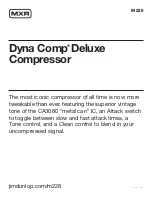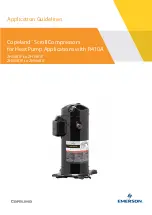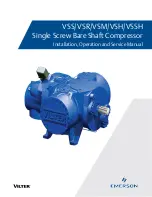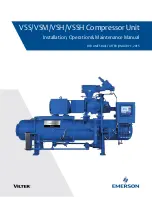
AGL_AC_ST_YRH_EN_Rev01
3
2
Product description
2.1 Compressor range
These application guidelines cover Copeland
™ scroll horizontal compressor models
YRH(V)*KTE/KTG (fixed- and variable-speed models). The Copeland scroll horizontal compressor
utilizes the same fundamental technology as the vertical models but incorporates a specific
lubrication system to enable horizontal operation. The variable-speed scroll compressors allow
precise matching of capacity over a much wider range than the fixed-speed models.
Compressor
Cooling capacity
(kW)
Motor
Frequency
range (Hz)
R454C
R290
YRH72KTE
13.1
TFD
50 Hz
YRH72KTG
13.4
TFD
50 Hz
YRHV72KTE
13.8
TX7
25-100 Hz
YRHV72KTG
13.4
TX7
25-100 Hz
YRH81KTE
15.3
TFD
50 Hz
YRH81KTG
14.6
TFD
50 Hz
YRHV81KTE
15.1
TX7
25-100 Hz
YRHV81KTG
14.8
TX7
25-100 Hz
Refrigerant dew point temperature, evaporating temperature: 5 °C; condensing temperature: 50 °C; suction
gas superheat: 10 K; liquid sub-cooling: 0 K; frequency: 50 Hz
Table 1: YRH(V)* model overview
2.2 Special requirements for transport applications
Transport applications for air conditioning, refrigeration or heat pump can be particularly sensitive
and require experience and thorough case-by-case analysis. Compared to stationary systems,
transport applications can have significantly higher requirements with regard to mechanical load,
system design, general function, tightness, conditions of the electrical supply and many other details.
The qualification for the whole system and all individual requirements, eg, component selection,
piping, piping layout, fixation, as well as a study about shock, vibration and load requirements must
be carried out by the system designer. Emerson can provide support and assistance with individual
projects.
Emerson requirements and recommendations for transport applications are as follows:
▪
During the risk assessment process and when dealing with R454C and R290, special attention
must be paid to flammability.
▪
Careful selection of mounting parts based on noise and vibration test results.
▪
Addition of external low leak check valves in the discharge line of the compressor for all models.
▪
Refrigerant charging into the liquid line and after the external check valve to avoid damage.
▪
Mandatory external discharge temperature protection for all compressors.
▪
Installation of a solenoid valve in the liquid line to the evaporator for pump-out, pumpdown or
high-to-low-side isolation purposes.
▪
Installation of low- and high-pressure controls, preferably direct acting.
▪
Carefully set inverter current limit for TX* motor versions, because there is no internal motor
protection.
▪
Addition of external phase sequence control to avoid reverse rotation and lubrication issues.
▪
Installation of hot gas bypass not recommended.







































